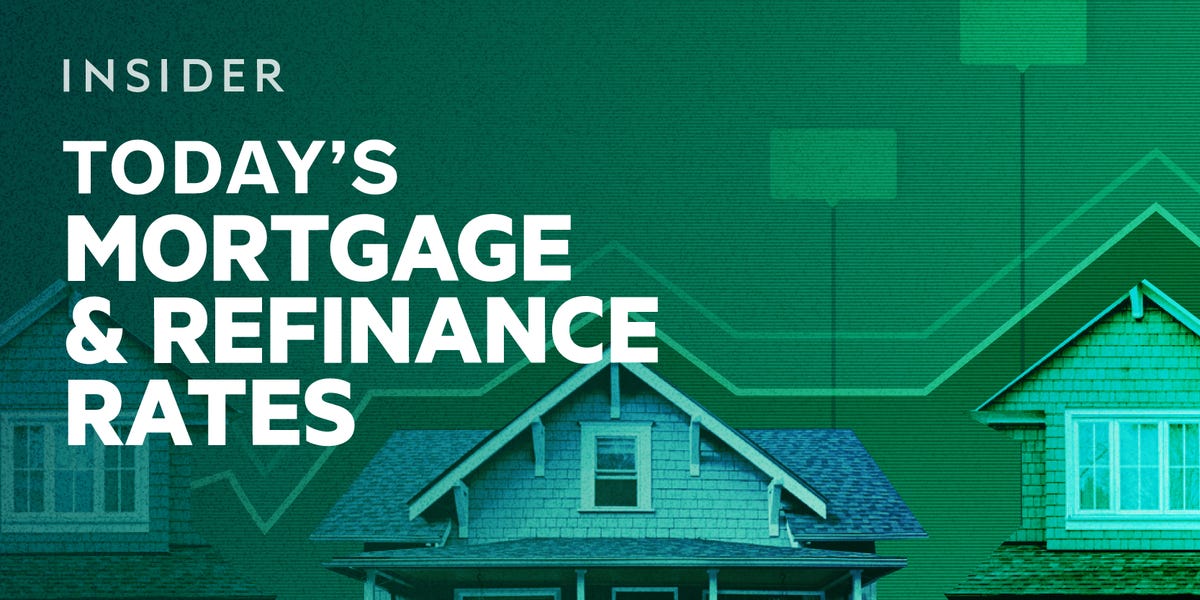Our experts answer readers’ home-buying questions and write unbiased product reviews (here’s how we assess mortgages). In some cases, we receive a commission from our partners; however, our opinions are our own.
Mortgage rates dropped unusually low last week, but they’re back up this week. Average 30-year mortgage rates are up around 43 basis points from where they were a week ago, according to Zillow data.
Right now, experts still believe mortgage rates will go down in 2024 and 2025. But recent hotter-than-expected economic data is keeping them elevated this month. As the economy continues to come into better balance throughout this year, mortgage rates should start to trend down.
Investors think that the Federal Reserve could start lowering the federal funds rates as soon as May or June of this year, according to the CME FedWatch Tool. While mortgage rates don’t directly follow the Fed’s benchmark rate, this would remove a lot of the upward pressure that has been keeping rates high. So once the Fed indicates that a rate hike is coming soon, we could see mortgage rates start to inch back down.
Current Mortgage Rates
| Mortgage type | Average rate today |
|
|
|
|
|
|
|
|
|
|
|
|
|
|
|
|
|
|
|
|
|
Current Refinance Rates
| Mortgage type | Average rate today |
|
|
|
|
|
|
|
|
|
|
|
|
|
|
|
|
|
|
|
|
|
Mortgage Calculator
Use our free mortgage calculator to see how today’s mortgage rates would impact your monthly payments. By plugging in different rates and term lengths, you’ll also understand how much you’ll pay over the entire length of your mortgage.
Mortgage Calculator
$1,161 Your estimated monthly payment
- Paying a 25% higher down payment would save you $8,916.08 on interest charges
- Lowering the interest rate by 1% would save you $51,562.03
- Paying an additional $500 each month would reduce the loan length by 146 months
Click “More details” for tips on how to save money on your mortgage in the long run.
Mortgage Rates for Buying a Home
30-Year Fixed Mortgage Rates Jump Up (+0.43%)
The current average 30-year fixed mortgage rate is 6.48%, up 43 points from where it was this time last week. This rate is also up a bit compared to a month ago, when it was 6.35%.
At 6.48%, you’ll pay $631 monthly toward principal and interest for every $100,000 you borrow.
The 30-year fixed-rate mortgage is the most common type of home loan. With this type of mortgage, you’ll pay back what you borrowed over 30 years, and your interest rate won’t change for the life of the loan.
20-Year Fixed Mortgage Rates Increase (+0.39%)
The average 20-year fixed mortgage rate is up quite a bit from last week, and is sitting at 6.22%. This time last month, the rate was 5.96%.
With a 6.22% rate on a 20-year term, your monthly payment will be $729 toward principal and interest for every $100,000 borrowed.
A 20-year term isn’t as common as a 30-year or 15-year term, but plenty of mortgage lenders still offer this option.
15-Year Fixed Mortgage Rates Go Up (+0.37%)
The average 15-year mortgage rate is 5.78%, up 37 points from last week. It’s also up somewhat compared to this time last month, when it was 5.66%.
With a 5.78% rate on a 15-year term, you’ll pay $856 each month toward principal and interest for every $100,000 borrowed.
If you want the predictability that comes with a fixed rate but are looking to spend less on interest over the life of your loan, a 15-year fixed-rate mortgage might be a good fit for you. Because these terms are shorter and have lower rates than 30-year fixed-rate mortgages, you could potentially save tens of thousands of dollars in interest. However, you’ll have a higher monthly payment than you would with a longer term.
7/1 ARM Rates Decrease (-0.30%)
The 7/1 adjustable mortgage rate is down 30 basis points from a week ago, currently at 6.44%. It’s also down a bit compared to this time last month, when it was at 6.76%.
At 6.44%, your monthly payment would be $628 toward principal and interest for every $100,000 borrowed — but only for the first seven years. After that, your payment would increase or decrease annually depending on the new rate.
5/1 ARM Rates Are Up (+0.42%)
The average 5/1 ARM rate is 6.91%, an increase from last week. It’s close to where it was a month ago, when it was 6.80%.
Here’s how a 6.91% rate would affect you for the first five years: You’d pay $659 per month toward principal and interest for every $100,000 you borrow.
30-year FHA Rates Inch Up (+0.11%)
The average 30-year FHA interest rate is 5.49% today, which is up 11 basis points from last week. This rate was 6% a month ago.
At 5.49%, you would pay $567 monthly toward principal and interest for every $100,000 borrowed.
FHA mortgages are good choices if you don’t qualify for a conforming mortgage. You’ll need a 3.5% down payment and 580 credit score to qualify.
30-year VA Rates Increase (+0.40%)
The current VA mortgage rate is 5.75%, up from this time last week. This rate was 5.63% a month ago.
With a 5.75% rate, your monthly payment would be $584 toward principal and interest for every $100,000 you borrow.
Mortgage Refinance Rates
30-Year Fixed Refinance Rates Tick Up (+0.19%)
The average 30-year refinance rate is 6.26%, just 19 basis points higher than last week. It’s down compared to a month ago, when it was 6.56%.
Here’s how a 6.26% rate would affect your monthly payments: You’d pay $616 toward principal and interest for every $100,000 borrowed.
Refinancing into a 30-year term can land you lower monthly payments, but you’ll ultimately pay more by refinancing into a longer term.
20-Year Fixed Refinance Rates Almost Flat (+0.03%)
The current 20-year fixed refinance rate is 6.07%, which is just 3 basis points up compared to a week ago. This rate was 6.02% this time last month.
A 6.07% rate on a 20-year term will result in a $720 monthly payment toward principal and interest for every $100,000 you borrow.
15-Year Fixed Refinance Rates Barely Move Down (-0.07%)
The average 15-year fixed refinance rate is 5.58%, which is down just 7 points compared to last week. This rate is also lower compared to this time a month ago, when it was at 6.03%.
A 5.58% rate on a 15-year term means you’ll pay $821 each month toward principal and interest for every $100,000 borrowed.
Refinancing into a 15-year term can save you money in the long run, because you’ll get a lower rate and pay off your mortgage faster than you would with a 30-year term. But it could result in higher monthly payments.
7/1 ARM Refinance Rates Go Up (+0.29%)
The average 7/1 ARM refinance rate is 7.56%, up 29 points where it was last week. A month ago, it was much lower at 6.04%.
Refinancing into a 7/1 ARM with a 7.56% rate means your monthly payment toward principal and interest will be $703 for every $100,000 you borrow. This will be the payment for the first seven years, then your rate will change annually unless you refinance again.
5/1 ARM Refinance Rates Rise (+0.12%)
The 5/1 ARM refinance rate is 7.32%, which is a tiny bit higher than it was this time last week. It’s up compared to this time last month, when it was 6.66%.
A 7.32% rate will result in a monthly payment of $687 toward principal and interest for every $100,000 borrowed. You’ll pay this amount for the first five years of your new mortgage.
30-Year FHA Refinance Rates Fall (-0.35%)
The 30-year FHA refinance rate is 5.81%, which down compared to last week. This rate was 5.95% this time last month.
A 5.81% refinance rate would lead to a $587 monthly payment toward the principal and interest per $100,000 borrowed.
30-Year VA Refinance Rates Increase (+0.34%)
The average 30-year VA refinance rate is 5.59%, which is 34 points higher compared to where it was was last week. This rate was 5.68% a month ago.
At 5.59%, your new monthly payment would be $573 toward principal and interest for every $100,000 you borrow.
Are Mortgage Rates Going Down?
Mortgage rates started ticking up from historic lows in the second half of 2021 and increased over three percentage points in 2022. Mortgage rates also rose dramatically in 2023, though they started trending back down toward the end of the year. We should continue to see them fall in 2024 and 2025.
For homeowners looking to leverage their home’s value to cover a big purchase — such as a home renovation — a home equity line of credit (HELOC) may be a good option while we wait for mortgage rates to ease further. Check out some of our best HELOC lenders to start your search for the right loan for you.
A HELOC is a line of credit that lets you borrow against the equity in your home. It works similarly to a credit card in that you borrow what you need rather than getting the full amount you’re borrowing in a lump sum. It also lets you tap into the money you have in your home without replacing your entire mortgage, like you’d do with a cash-out refinance.
Current HELOC rates are relatively low compared to other loan options, including credit cards and personal loans.







